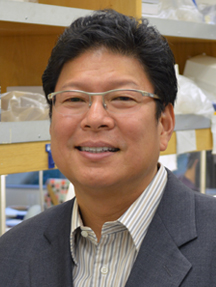Revealing the Secrets of Brain Cells: A Profile of Jerold Chun
By Madeline McCurry-Schmidt
Jerold Chun, a professor at The Scripps Research Institute (TSRI), heads to Honolulu every year to run a marathon, a streak now at 42 years, but when he was a kid, smaller journeys captured his imagination.
“My dad was one of these really old-school, bow-tie physicians,” Chun said. “I used to follow him around on house calls. He had a black bag and he would see patients at their homes.”
After house calls, it was common for families to pay their medical bills with fruit, fish or chickens. “The good you could do through medicine left a big impression on me,” Chun said.
Today, Chun conducts scientific research to help find cures for people with neurological and psychiatric diseases such as Alzheimer’s, Parkinson’s and schizophrenia. His work has revealed some surprising phenomena in the brain.
The Bard and the Brain
Chun’s focus on neuroscience began, strangely enough, as he worked on a degree in English literature at the University of Hawaii at Manoa. As he read the Romantic Era poetry of Wordsworth and the pun-filled plays of Shakespeare, he began to wonder how one species, humans, could come up with such a vast range of ideas and writings.
“These written works are all produced by humans—by us—and that made me wonder if I could understand that at a scientific level, by understanding the brain,” said Chun.
Literature also seemed like a window into understanding human behavior. Take the works of William Shakespeare. While Shakespeare wasn’t a scientist, he did portray human humor, tragedy and madness. “I think if you could understand all the nuances of Shakespeare, you’d understand much about people and how the brain makes us human,” said Chun.
Inspired, Chun ended up pursuing an MD and PhD in neuroscience at Stanford University. There he studied how the cerebral cortex, the brain region responsible for higher thought, develops. After a positions at MIT and the University of California, San Diego, Chun joined the TSRI faculty in 2003.
A Closer Look at the Brain
So what makes a Shakespeare or an Einstein? An artist or an engineer?
Chun’s research shows that some differences in human behavior—and disease risk—could come down to mutations in the DNA of individual brain cells.
In 2001, Chun was the first to report that the brain contains many distinct genomes within its cells—much like the colorful tiles in an artist’s mosaic. He and his colleagues showed that some brain cells can gain or sometimes lose a chromosome, a state referred to as aneuploidy. Over the years, a wide range of DNA changes in single brain cells has been identified, which is referred to as “genomic mosaicism.”
In 2015, Chun’s lab showed that genomic mosaicism was linked to the most common form of Alzheimer’s disease, called “sporadic” (non-inherited). The brains of people who had died with sporadic Alzheimer’s disease showed many cells with many millions of extra DNA base-pairs, including more copies of the APP gene, which can lead to production of the primary component of damaging amyloid plaques in diseased brains
Blood tests to identify genes that cause sporadic Alzheimer’s disease have not been successful and Chun’s results could explain why—these extra gene copies and other DNA changes exist only in certain cells of the brain. The research also provides a path for finding new genes from the amplified DNA.
Looking beyond Alzheimer’s disease, Chun’s lab also discovered the first receptors for small fat molecules called lysophospholipids, which his lab linked to many brain diseases, including multiple sclerosis, hydrocephalus and pain. A recent study from Chun’s lab and colleagues at the University of Southern California revealed the 3D structure of one of these receptors, the lipid called lysophosphatidic acid (LPA), letting scientists create a “roadmap” of this receptor molecule that could lead to the creation of new drugs.
Another recent study, this time a collaboration with Associate Professor Beth Thomas’s lab at TSRI, identified LPA receptors in the developing brain that can initiate schizophrenia-like brain changes and behaviors in animal models.
Chun said collaboration is key in his field. “There’s this stereotype of a scientist with a lab coat and thick glasses squirreled away somewhere—but that’s not true,” said Chun. “Science is not a weird, solitary event, but rather a human, social activity.”
And that makes him particularly grateful to be working at TSRI.
“There’s fantastic, cutting-edge research going on all the time—with brilliant minds to talk to,” said Chun. “We’re all here to push the frontiers of knowledge with research that can help people.”
An Impact in the Community
Over the past year, Chun has been reaching out to caregivers and Alzheimer’s patients through the San Diego County Alzheimer’s Project. The project gives Chun new opportunities to collaborate with researchers at nearby institutions like the Sanford-Burnham-Prebys Medical Discovery Institute and the University of California, San Diego. The goal is to combine resources to find new treatments more quickly.
“That’s been really great because it has brought together folks from academia as well as the healthcare industry,” said Chun.
Chun said that giving presentations for the Alzheimer’s Project and other outreach events has shown him the impact of his research. After nearly every event, an audience member approaches him to talk about a loved one with Alzheimer’s or even ask if they can help with the research itself. “That doesn’t leave you—it’s with you all the time,” said Chun.
“What do you do in the time you have, to make a real difference? For me, it’s working on these diseases that afflict your family, my family and, quite possibly, ourselves at some point. We want our work to really help patients, to really make a positive difference.”
Send comments to: press[at]scripps.edu















